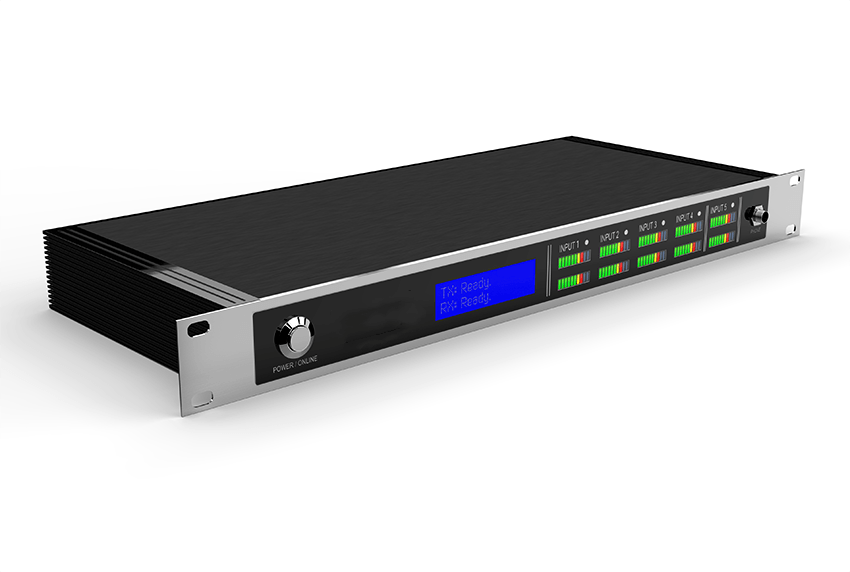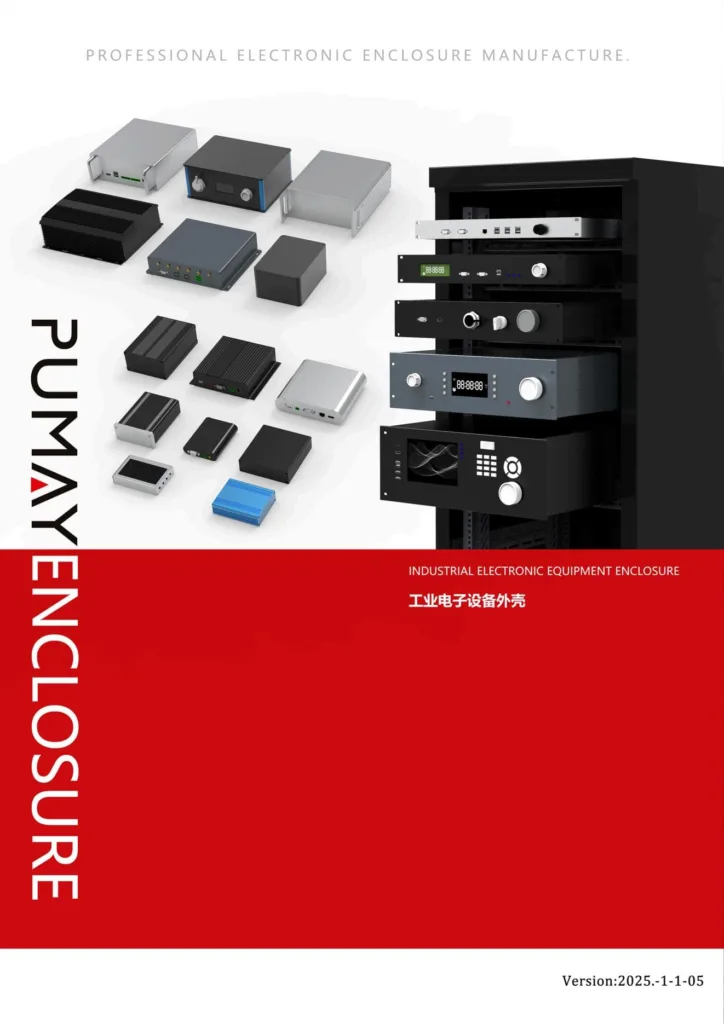Are standard rackmount cases limiting your unique equipment designs? Off-the-shelf solutions often mean compromises in fit, cooling, or I/O access, hindering optimal performance.
Customization for 19-inch aluminum rackmount cases includes tailored depths, variable heights (U units), specific ventilation patterns, precise cutouts for connectors and displays, diverse finishes like anodizing or powder coating, branding options, and specialized internal mounting arrangements for components.
 "Custom 19-Inch Rackmount Cases")
"Custom 19-Inch Rackmount Cases")
Now that we've outlined the possibilities, let's delve into why this is so important. When I first started PUMAYCASE, our slogan "Enclosing Innovation, Delivering Precision" wasn't just about small project boxes; it extended to complex systems like those housed in 19-inch racks. Engineers like Jeff, who develop specialized R&D instruments, often find that standard rack cases just don't cut it. They need specific dimensions, unique I/O panel layouts, and optimized cooling. Customization isn't a luxury; it's a necessity for peak performance and a professional finish. It's about making the case work perfectly for the valuable electronics inside.
What is the spacing for a 19 rack mount?
Confused by rack unit "U" measurements and how they define vertical space? Miscalculating this can lead to components not fitting or valuable rack space being wasted.
The vertical spacing for a 19-inch rack mount is defined by the "rack unit" (U). One rack unit (1U) is precisely 1.75 inches (44.45 mm) high. Equipment height is always specified in multiples of U.
 "19-Inch Rack Unit Spacing")
"19-Inch Rack Unit Spacing")
Let's dive deeper into this fundamental standard. Understanding the "U" is the first step in planning any rack-mounted system. It's a simple concept, but absolutely critical for compatibility.
Understanding the Rack Unit (U)
The term "rack unit," abbreviated as U, is the standard way to measure the height of equipment intended for a 19-inch rack. As mentioned, 1U equals 1.75 inches or 44.45 millimeters. So, if you see equipment listed as 2U, it means its front panel height is 2 x 1.75 inches = 3.5 inches. This standardized unit ensures that equipment from different manufacturers can fit together seamlessly within the same rack structure. I remember when I first started working with aluminum profiles, seeing these precise measurements applied across such large structures was impressive.
Hole Spacing and Mounting Rails
The vertical mounting rails within a 19-inch rack have a specific hole pattern dictated by the EIA-310 standard. The holes are arranged in repeating groups of three. The distance between the center of the top hole in one group and the center of the top hole in the group directly below it (or above it) defines 1U, which is 1.75 inches. This consistent pattern is what allows you to mount 1U, 2U, 3U, or larger equipment correctly. These holes can be pre-tapped (commonly 10-32 UNF, 12-24 UNF, or M6 metric) or square to accommodate cage nuts, offering flexibility.
At PUMAYCASE, we ensure our custom aluminum rackmount cases strictly adhere to these U spacing standards for their mounting flanges. This means an engineer like Jeff can design a custom 3U instrument knowing its PUMAYCASE enclosure will mount perfectly into any standard rack, alongside other equipment. The precision of our CNC machining is key here.
What are the specifications for EIA 19 rack?
Building or buying a 19-inch rack system for your project? Not being familiar with the EIA-310 standards can lead to incompatible equipment and very costly mistakes.
The EIA-310 standard (currently EIA/ECA-310-E) specifies a rack frame for 19-inch (482.6 mm) wide equipment panels. Key features include vertical mounting rails with holes spaced to accommodate 1.75-inch (1U) height increments.
 "EIA-310 Rack Specifications")
"EIA-310 Rack Specifications")
Let's dive deeper into these critical specifications. The EIA-310 standard is the bedrock of the 19-inch rack industry, ensuring interoperability for a vast range of equipment, from servers and network gear to audio components and test instruments.
Key EIA-310 Dimensions
Several dimensions are crucial for compatibility:
- Panel Width: The most recognized dimension is the 19-inch (482.6 mm) width of the equipment's front panel. This is what allows it to span between the vertical mounting rails.
- Unit Height (U): As we discussed, 1U is 1.75 inches (44.45 mm). Rackmount equipment and cases are designed in integer multiples of U.
- Horizontal Hole Spacing on Rails: The horizontal distance between the centerlines of the two front vertical mounting rails where equipment is attached is typically 18 5/16 inches (18.3125 inches or 465.1 mm).
- Vertical Hole Pattern: The mounting holes on the vertical rails follow a specific pattern: a space of 0.625 inches (15.875 mm) between the center of hole 1 and hole 2, 0.625 inches between hole 2 and hole 3, and then 0.5 inches (12.7 mm) between hole 3 of one U-space and hole 1 of the next U-space. This repeating 0.625-0.625-0.5 inch pattern perfectly defines the 1.75-inch U space.
Other Specifications
The standard also covers aspects like:
- Mounting Hole Types: Typically specifying options for tapped holes or square holes for cage nuts.
- Rack Opening Width: The clear opening between the rails for the equipment chassis to pass through is slightly less than the panel width.
- Rail Thickness and Strength: To ensure they can support the weight of mounted equipment.
| Specification | Dimension/Detail | Importance for Compatibility |
|---|---|---|
| Front Panel Width | 19 inches (482.6 mm) | Universal equipment width standard |
| Rack Unit (1U) Height | 1.75 inches (44.45 mm) | Standard for vertical sizing |
| Vertical Hole Pattern | 0.625", 0.625", 0.5" repeating | Defines U spacing, ensures proper alignment |
| Horizontal Rail Centers | 18.3125 inches (465.1 mm) | Positions rails for 19" panel mounting |
| Mounting Hole Type | Tapped (e.g., 10-32) or Square (cage nut) | Dictates fastener type |
At PUMAYCASE, our design and manufacturing processes, especially our CNC machining capabilities, are geared to maintain these EIA-310 tolerances meticulously. This is crucial for Jeff, whose specialized instruments often need to integrate seamlessly into existing rack infrastructure worldwide. Clear technical communication about these specs is part of our engineer feedback within 24 hours.
What size is a rackmount case?
Defining "size" for a rackmount case seems simple, but it's more than just width. Understanding all key dimensions is vital for your equipment layout and integration plans.
A rackmount case "size" primarily refers to its standard 19-inch front panel width for rack compatibility. Its height is given in rack units (U), and its depth can vary significantly based on the enclosed equipment.
 "Rackmount Case Dimensions")
"Rackmount Case Dimensions")
Let's dive deeper into the three primary dimensions that define the size of a rackmount case. Getting these right ensures your equipment not only fits the rack but also functions optimally within its enclosure.
The Three Key Dimensions
- Width: This is the most standardized dimension. The front panel of a rackmount case is designed to be 19 inches (482.6 mm) wide. This allows it to be mounted into any standard 19-inch equipment rack. The actual chassis body behind the front panel will be slightly narrower to fit between the vertical mounting rails.
- Height: The height is specified in Rack Units (U), where 1U is 1.75 inches (44.45 mm). Cases come in various heights like 1U, 2U, 3U, 4U, and so on. The choice depends on the vertical space required by the internal components. At PUMAYCASE, while we adhere to standard U increments for the mounting flanges, the actual internal usable height can be optimized during custom design.
- Depth: This is the most variable dimension and often the most critical for customization. There's no single standard depth for rackmount cases. Depths can range from a few inches for shallow devices like patch panels to several feet for deep servers or specialized instrumentation.
Why Depth Customization is Crucial
The depth of the case is driven by:
- The physical size of the largest internal component (e.g., a long PCB, a power supply).
- The need for internal airflow and cable management.
- The depth of the rack cabinet it will be installed into.
I recall a project with Jeff where he was developing a compact industrial controller. Standard depth cases were far too deep, wasting space in the client's cabinet and potentially creating airflow "short circuits." We were able to provide a PUMAYCASE aluminum rackmount case with a custom shallow depth, perfectly fitting his components and the client's space constraints. This level of customization in depth is a significant advantage our standard extrusions + modular end plates system offers, enabling rapid customization without full custom tooling for every dimension.
What is the depth of a 19-inch rack?
Is there a single, "standard" depth for a 19-inch rack or a rackmount case? This common question often leads to confusion because depths can vary widely.
There isn't one universal "standard" depth for a 19-inch rack cabinet or rackmount case. Depths are application-dependent, commonly ranging from shallow (e.g., 150mm/6in) to very deep (e.g., 1200mm/47in) for servers.
 "Various 19-Inch Rack Depths")
"Various 19-Inch Rack Depths")
Let's dive deeper into rack and case depths. While the 19-inch width is fixed for interoperability, the depth dimension is highly flexible to accommodate an enormous variety of equipment types.
Common Depth Ranges and Their Applications
Rack cabinets (the structures that hold the cases) and the cases themselves come in various depths:
- Shallow Depths (e.g., 200mm to 450mm / approx. 8 to 18 inches): These are common for networking equipment like patch panels, smaller switches, audio gear, and some types of instrumentation. Cases in this range are often lighter and easier to handle.
- Medium Depths (e.g., 500mm to 800mm / approx. 20 to 31 inches): This range accommodates many general-purpose servers, UPS (Uninterruptible Power Supply) units, and a wide variety of industrial control systems and test equipment. This is a very common depth range.
- Deep Depths (e.g., 800mm to 1200mm+ / approx. 31 to 47+ inches): These are typically required for high-density servers, large storage arrays, and specialized telecommunications equipment that have very long chassis. These racks also often need more space for extensive rear cable management.
Factors Influencing Depth Choice for a Rackmount Case
When selecting or customizing the depth of an aluminum rackmount case at PUMAYCASE, we help clients like Jeff consider:
- Internal Component Dimensions: The largest PCB, power supply, or other module dictates the minimum internal depth.
- Internal Airflow: Sufficient space is needed for air to circulate and cool components effectively. Custom ventilation patterns, which we can easily add, also play a role here.
- Cable Management: Adequate depth allows for orderly routing of power and data cables, preventing kinks and airflow blockages.
- Rack Cabinet Constraints: The case must, of course, fit within the available depth of the rack cabinet it will be installed in, leaving some room for rear cabling and airflow.
Our ability at PUMAYCASE to offer precisely customized depths for aluminum rackmount cases is a key advantage. We can adjust the length of our standard aluminum extrusions and then use CNC-machined front and rear panels to create a case of nearly any required depth. This flexibility helps engineers like Jeff optimize their designs without being constrained by off-the-shelf depth limitations, ensuring a perfect fit and function for their innovative products. This is particularly important when trying to balance IP rating requirements with lightweight design and thermal management.
Conclusion
Customizing 19-inch aluminum rackmount cases ensures your equipment fits perfectly, performs optimally, and looks professional. Precision in design and manufacturing makes all the difference.





